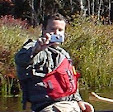 |
| Brown University Boathouse |
I put
in at Bold Point Park and paddled up though the narrows between Bold Point in
East Providence and India Point in Providence. India Point was the first port of Providence. It was established in 1680 and was the base of operations for John Brown’s East India fleet in the second half of the 18th century. John Brown and his brothers would go on to found Brown University.
I paddled by the Brown University Boat House and under the George Washington Bridge that carries Route 195 across the Seekonk River. In 1781, George Washington marched his army across the Seekonk River at this point on his way to a siege of British forces in New York.
I paddled by the Brown University Boat House and under the George Washington Bridge that carries Route 195 across the Seekonk River. In 1781, George Washington marched his army across the Seekonk River at this point on his way to a siege of British forces in New York.
 |
| "Stuck-open" Bridge |
Above
the George Washington Bridge is the “Stuck-open” Bridge. Also known as the Crook Point Bascule Bridge, this railroad bridge
was constructed in 1908 and has been abandoned in the open position since
1976. A bascule
bridge is a drawbridge with a counterweight that continuously balances a
span through its upward swing to provide clearance for boat traffic.
Just before the “Stuck-open” Bridge on the
Providence side of the river is Roger Williams Park. It was on this site that Roger Williams first landed in what
would become Providence after rowing down the Ten Mille River and across the Seekonk River in 1636. Williams would eventually row around
India Point and up the Providence River to establish the Providence colony in
what is now downtown Providence.
Above
the “Stuck-open” Bridge is the Henderson Bridge and Bailey’s
Cove. From here, the Seekonk River
is wide open and very susceptible to wind, which gets channeled up the course
of the river. I paddled up the more
scenic Providence side along Blackstone Park, the Narragansett
Boat Club and the Swan Point Cemetery. The Ten Mile River and the Omega Dam join the Seekonk River on the East Providence side.
 |
| Narragansett Boat Club |
Further
upstream is Swan Point and the Swan Point Cemetery. Established in 1858 and
redesigned in 1886,
the Swan Point
Cemetery is the final resting place for many of Providence’s most important
citizens. I paddled past Stony
Point at the far end of the Swan Point Cemetery into Pawtucket at Bensley Point.
From
here, the river narrows as I paddled past the School Street and the Taft
Street boat ramps. Seagulls filled
the air, fishermen lined to the shore and a large school of small silver fish
seemed to be jumping out of the water just about everywhere. I was told that these
fish were pogies or menhadens
that spend their juvenile years in the less saline waters of tidal estuaries
like the Seekonk River. I paddled under the Division Street
Bridge, under the new Route 95 Bridge, and up to the Pawtucket Falls under the
Main Street Bridge.
 |
| Pawtucket Falls and the Slater Mill |
With nowhere left to
go, it was time to turn around and began my trip back downstream. For most of the trip upstream, the wind had been at my back kicking up small rolling waves. In addition to the wind, the tide was
coming in, so I knew it would be a long slog paddling back downstream. I made surprisingly good progress by
switching sides frequently and maintaining momentum.
By
the time I reached the Narragansett Boat Club the sculling crews were out on
the river. There were big 8-man
boats from Brown University, and a mixture of smaller boats from the
Narragansett Boat Club. I matched
paces with an eight-woman shell for a while, and was feeling pretty smug until
the coach picked up the pace and the boat disappeared into the distance.
 |
| Eight-(wo)man shell from Brown University |



No comments:
Post a Comment
Note: Only a member of this blog may post a comment.